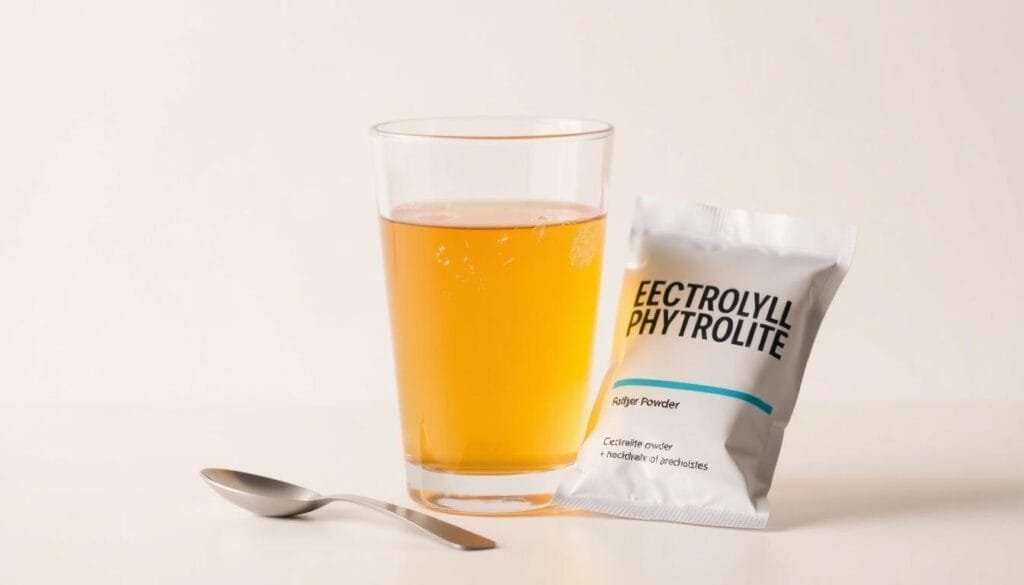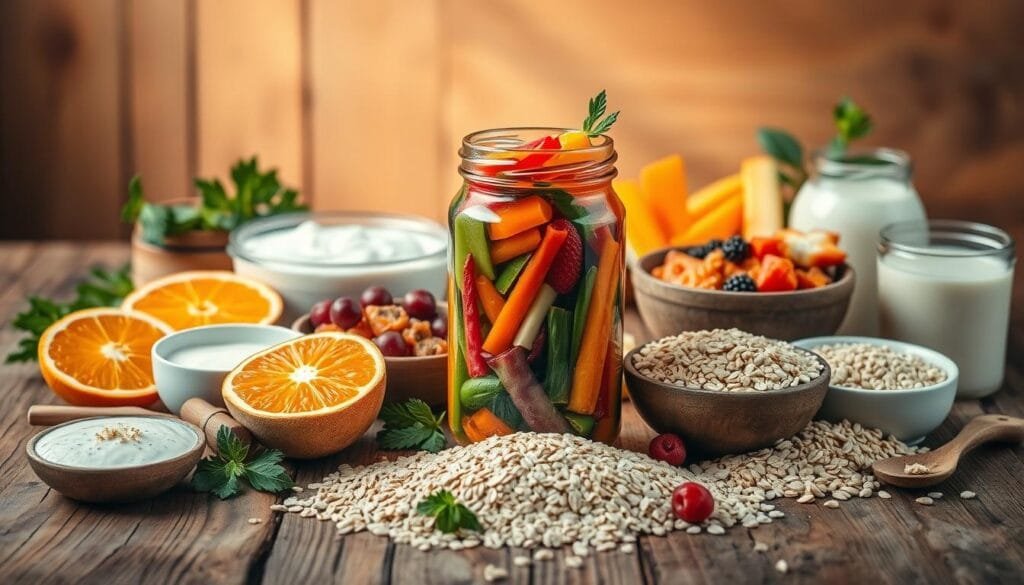Currently Empty: RM0.00
Digestive distress often lingers long after stomach issues resolve. Contaminated meals can strip the body of essential microbes, weakening natural defenses. This imbalance leaves many feeling fatigued and vulnerable to recurring problems.
Restoring microbial diversity becomes critical during recovery. Beneficial bacteria act as frontline defenders, crowding out harmful organisms. Research shows replenishing these microorganisms supports nutrient absorption and reduces inflammation.
Strategic dietary choices accelerate healing. Fermented items like yogurt and tempeh introduce live cultures that repopulate the intestinal tract. Hydration and fiber-rich foods create an optimal environment for microbial growth.
This guide explores science-backed methods to strengthen digestive resilience. Readers will discover how specific strains target lingering effects of contamination while boosting immunity. Practical tips help maintain long-term balance through simple lifestyle adjustments.
Key Takeaways
- Digestive disruption often continues after visible symptoms disappear
- Microbial imbalance increases vulnerability to future infections
- Targeted nutritional support speeds recovery processes
- Specific bacterial strains enhance immune function
- Dietary adjustments sustain long-term intestinal balance
- Proper hydration supports microbial regeneration
Understanding Food Poisoning and Its Impact on Gut Health
Harmful pathogens in food don’t just cause immediate sickness. They trigger a biological chain reaction that reshapes your digestive landscape for weeks. Consuming contaminated items introduces invaders like Salmonella or E. coli, which wage war against your body’s natural defenses.
What Triggers Digestive Crises
Contaminated meals often contain microscopic troublemakers. Undercooked chicken might harbor Campylobacter, while unwashed greens could carry Shigella. These organisms multiply rapidly, overwhelming your system’s protective barriers.
| Pathogen | Common Sources | Incubation Period |
|---|---|---|
| Salmonella | Raw eggs, poultry | 6-72 hours |
| E. coli | Unpasteurized dairy | 3-4 days |
| Campylobacter | Undercooked meat | 2-5 days |
Gut Ecosystem Disruption
Violent expulsion through vomiting or diarrhea does more than remove toxins. It flushes out crucial microorganisms that maintain intestinal harmony. This creates openings for harmful strains to dominate.
“The gut becomes a battlefield post-contamination – both invaders and defenders get eliminated during the body’s cleanup efforts.”
Recovery isn’t just about stopping nausea or cramps. It requires rebuilding microbial populations that process nutrients and guard against future threats. Hydration and gentle nutrition form the foundation, but true healing demands strategic repopulation of beneficial strains.
Hydration and Nutrition: The First Steps of Recovery
Rebuilding strength starts with fundamental care for your body’s needs. Proper fluid intake and gentle nourishment create the foundation for lasting healing.

Replacing Lost Fluids and Electrolytes
Dehydration poses the greatest risk during recovery. Vomiting and diarrhea drain vital minerals like sodium and potassium. Begin with small sips every 15 minutes after symptoms ease.
Effective options include:
- Plain water with a pinch of salt
- Coconut water for natural electrolytes
- Specialized solutions (Pedialyte® or CeraLyte®)
“Sipping slowly prevents overwhelming the stomach. Aim for 1-2 liters daily in the first 48 hours.”
Introducing Bland Foods Gradually
Once liquids stay down for 4-6 hours, try simple carbohydrates. The BRAT diet offers low-fiber choices that reduce intestinal strain.
Start with:
- Mashed bananas for potassium
- Plain rice porridge
- Unsweetened applesauce
Boiled potatoes and steamed chicken breast add protein without irritation. Avoid spicy, fatty, or dairy-heavy meals for 3-5 days.
Probiotics after food poisoning
Rebalancing intestinal ecosystems becomes vital following digestive distress. Beneficial microbes act as nature’s cleanup crew, repairing damage caused by invading organisms. These microscopic allies reinforce the body’s ability to process nutrients while creating hostile conditions for lingering threats.
Role of Beneficial Microbes in Gut Recovery
Specific microbial strains excel at recolonizing damaged digestive environments. Research highlights four powerful defenders:
| Strain | Key Benefit | Effectiveness |
|---|---|---|
| Lactobacillus acidophilus | Reduces inflammation | 34% faster recovery |
| Bifidobacterium bifidum | Strengthens gut lining | 2.5x pathogen resistance |
| Saccharomyces boulardii | Prevents diarrhea recurrence | 67% success rate |
| Lactobacillus rhamnosus | Boosts immunity | 41% fewer infections |
Mechanisms of Digestive Support
These microbial warriors operate through three primary strategies. First, they crowd out dangerous organisms by consuming available nutrients. Second, they reinforce intestinal walls to prevent toxin leakage. Third, they train immune cells to recognize threats faster.
“Clinical trials show specific strains reduce diarrhea duration by 25 hours compared to placebo groups.”
Consistency proves crucial – daily intake for 4-6 weeks helps establish stable colonies. Pairing microbial supplements with fiber-rich foods enhances their survival and growth. This dual approach creates lasting protection against future imbalances.
How to Integrate Probiotics into Your Diet

Rebuilding gut resilience requires smart microbial allies. Choosing the right delivery method and schedule helps maximize their effectiveness while respecting your body’s healing process.
Natural Sources vs. Concentrated Formulas
Fermented items like unsweetened yogurt and kimchi offer live cultures alongside vitamins and minerals. These nutrient-dense foods work best when digestion stabilizes. Consider these options:
| Food Source | Key Strain | Best For |
|---|---|---|
| Kefir | Lactobacillus kefiri | Daily maintenance |
| Sauerkraut | Leuconostoc mesenteroides | Diverse colonies |
| Tempeh | Bifidobacterium breve | Protein support |
Supplements provide targeted solutions for sensitive stomachs. Shelf-stable capsules containing Saccharomyces boulardii or Lactobacillus rhamnosus avoid potential irritants in fermented products. Those recovering from antibiotic treatments might find specific strain combinations particularly helpful.
Strategic Scheduling for Maximum Impact
Most healthcare providers suggest waiting until nausea subsides before introducing microbial support. Begin with small doses:
- Day 1-3: 1-2 billion CFU with morning meals
- Day 4-7: Gradually increase to 5-10 billion CFU
- Week 2+: Maintain with food-based sources
“Start low and slow – your gut needs time to welcome new residents without causing traffic jams.”
Pair supplements with oatmeal or steamed vegetables during early recovery. This gentle approach helps microbial colonies establish themselves without overwhelming healing tissues.
Lifestyle and Preventative Measures for Lasting Gut Health
Daily habits play a crucial role in keeping your digestive system strong and resilient. Simple choices create environments where beneficial microbes thrive while keeping harmful invaders at bay.
Building Microbial-Friendly Routines
A diverse plate supports microbial diversity. Aim for colorful meals featuring these prebiotic-rich options:
- Roasted garlic in soups or stir-fries
- Overnight oats with sliced bananas
- Grilled asparagus alongside lean proteins
Hydration works hand-in-hand with nutrition. Herbal teas and infused waters help flush toxins while maintaining mucosal linings. Those recovering from stomach issues should sip warm liquids between meals.
“Prevention starts in the kitchen – proper handling reduces infection risks by 72% according to food safety studies.”
Three key practices protect vulnerable groups like older adults and pregnant women:
- Store raw meats separately from produce
- Use separate cutting boards for proteins and vegetables
- Check refrigerator temperatures (below 4°C)
Stress management and quality sleep often get overlooked. Just 30 minutes of daily walking improves microbial diversity, while 7-8 hours of rest allows the body to repair gut lining naturally.
Expert Tips and Wellness Concept Information
Navigating digestive recovery requires both personal effort and professional insight. Recent research shows tailored approaches yield better outcomes than generic solutions. Always consult healthcare providers before starting new regimens, particularly for children or those with compromised immunity.
Personalized Support Options
Wellness Concept’s team offers science-backed advice through WhatsApp consultations at +60123822655. Their specialists analyze individual needs, considering factors like symptom duration and existing conditions. This service helps people make informed choices about microbial support and dietary adjustments.
Accessible Wellness Resources
Available Monday-Friday (9:30 AM-6:30 PM) and weekends (10 AM-5 PM), these experts provide practical strategies for restoring intestinal balance. Studies indicate combining professional guidance with home care reduces recovery time by 18% in most cases.
Remember – what works for one person might not suit another. Ongoing research continues to refine best practices for maintaining gut health after illness. Trusted advisors can help decode complex information into actionable steps for lasting wellness.
FAQ
How does food poisoning affect the digestive system?
Harmful bacteria from contaminated meals can disrupt the balance of good microbes in the gut. This imbalance often leads to symptoms like vomiting, diarrhea, and stomach cramps, which may weaken the immune system temporarily.
What should someone eat during recovery?
Bland options like bananas, rice, applesauce, and toast (BRAT diet) are gentle on the stomach. Gradually reintroduce easy-to-digest meals like oatmeal or boiled potatoes once nausea subsides. Avoid spicy, fatty, or dairy-heavy foods initially.
Are electrolyte drinks necessary after vomiting or diarrhea?
Replacing lost fluids is critical. Oral rehydration solutions like Pedialyte® or coconut water help restore sodium, potassium, and glucose levels. Sipping small amounts frequently prevents dehydration without overwhelming the stomach.
Can fermented foods speed up gut healing?
Yogurt with live cultures (e.g., Activia®), kefir, or kimchi introduce beneficial strains like Lactobacillus, which may reduce inflammation and support microbial balance. These options work alongside supplements but consult a healthcare provider for severe cases.
When is the best time to take probiotic supplements?
Start once acute symptoms like frequent vomiting ease—usually 24–48 hours post-poisoning. Brands like Culturelle® or Align® recommend taking capsules with meals to enhance survival through stomach acid. Follow dosage guidelines on the label.
How long does it take to rebuild gut health?
Mild cases might improve within a week, but full recovery varies. Consuming fiber-rich foods, staying hydrated, and managing stress aids long-term resilience. Persistent issues beyond 3–4 days warrant medical advice.
Can Wellness Concept provide personalized recovery plans?
Yes! Their team offers consultations via WhatsApp (+60123822655) during business hours (Mon–Sat, 9 AM–6 PM). They tailor advice on diet, supplements, and lifestyle adjustments for lasting wellness.


